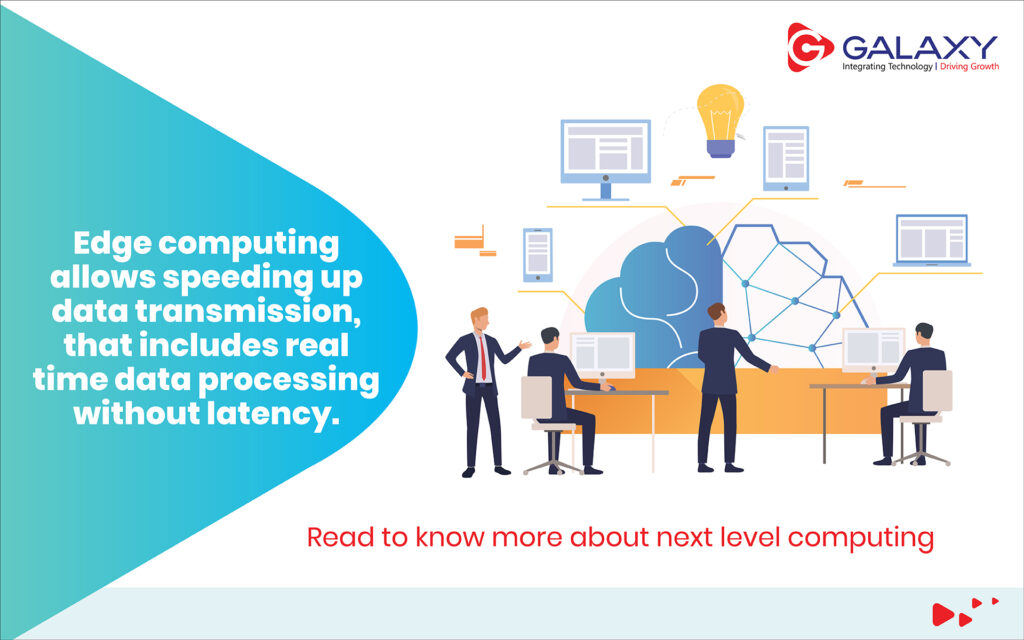As we move into a new decade of 2020, technological advancement is surely at the top priority of every organization. We are living in a data-driven world where the estimated data generated by average person is 1.5 GB per day. With the increasing number of IoT devices/applications and bulk data generated, performing computation at data centers or cloud servers isn’t sufficient or efficient. Cloud computing has proved its efficiency to many enterprises by focusing on core business competence and reducing cost. Using cloud, the data was sent and accessed from a remote server. It uses Internet-based services to support business processes. But the built-in latency of cloud is no longer capable of deploying machine intelligence and getting real-time outputs. Truly the technology has made the lives of people easier but that’s not all and here comes Edge computing to make computing faster. It’s the next wave in evolving data center infrastructure, powered by Internet of Things (IoT) technologies and 5G network.
Over the past many years, organizations have started to integrate cloud into their infrastructure. Few thinks that edge computing might replace cloud computing. But that’s not true, it just means that cloud is coming near to you. Organizations need to implement both edge and cloud computing together to handle the ever-growing data in coming future. Surely, edge computing will reduce the volume of data transmitted over the internet to cloud, but it cannot replace the cloud. Despite the fact the major part of data is processed or analyzed at the device, but data still needs to be stored somewhere for future reference, and that’s where cloud is important. Edge and cloud are used just as we use our two hands.
What is Edge Computing?
The term “Edge” in this context, correlates to the geographic distribution of network resources. Edge computing allows to perform data collecting, analyzing and computing close to the data source instead of relying on a centralized cloud network that can be thousands of miles away. Edge computing distributes data from centralized network and deploys it to micro-data centers which makes them closer to data generation.
Key advantages of Edge Computing
- Data without latency: Edge computing permits in speeding up data transmission because data travel time decreases. It enables applications to respond to data almost abruptly.
- Reduces Internet Bandwidth: Relying less on cloud means certain data or applications can be operated reliably offline. This will be very useful in areas where network connectivity is low.
- Provides certain level of Security: As data is collected and operated at local level, sensitive data transfer to cloud can be avoided and hence impact would be less if the cloud has been cyber attacked.
- Reliable: Edge computing has a great security advantage which make it more reliable. In situation like data center downtime, IoT edge computing devices can operate uninterrupted because the vital processing is done locally. The chances of unavailability of data entirely is almost completely zero.
IoT development can be seen in businesses across every industry. IoT devices will need edge computing and 5G network to work effectively. Providentially, the expansion of edge computing will make easier for businesses to scale their operations. Companies no longer need to set up centralized or private data centers that are expensive to assemble, maintain or replace when its time to expand data analysis. Organizations can easily expand their edge network quickly and cost-effectively by combining alliance services with edge computing data centers. Adaption to evolving markets and scaling their data needs, organizations doesn’t have to rely upon a centralized infrastructure anymore.
Edge computing can serve variety of businesses and is a diversion for almost all sectors of the world whether manufacturing or construction, financial or health care, people will slowly adopt the edge. Banking sector is implementing edge computing to provide ATMs with potential to collect and process data with faster response time. For finance firms those dealing with funds and shares are also adopting edge computing by placing servers in data centers near stock exchanges to provide accurate and up to date information without any lag which could lead to real loss of money.
Enterprises investing in edge computing should know that it is not a general-purpose platform like cloud computing but it’s a specialized approach to solve specific set of issues. Just adopting the technology because it’s a trend doesn’t serve the need. So, organizations should first ensure whether the investment is really required. Edge computing still have to overcome various challenges to be practically used on a larger scale. But once edge computing becomes the wave, it’s going to change the way business is done.
Are you using cloud computing and ready to upgrade your game point of business by advancing to Edge computing?
Please write to us at marketing@goapl.com
FOR A FREE CONSULTATION, PLEASE CONTACT US.

